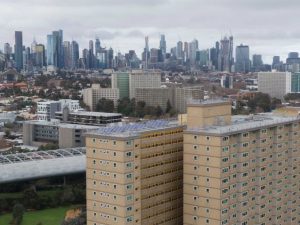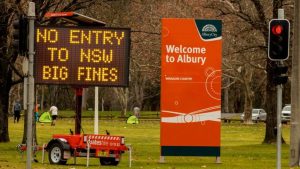Since the outbreak of the COVID-19 pandemic, Australia has managed to gain control of initial outbreaks in states by enforcing restrictions and lifting them accordingly. Now, the state of Victoria has seen a spike of 191 new cases of COVID-19 in one day and the Victorian Premier Daniel Andrews, unanimously with NSW Premier Gladys Berejiklian and the support of the Australian Prime Minister, Scott Morrison, has decided to close the border between the two states temporarily.
In reality, despite Melbourne being a hotspot for the spread of the virus, it seems that the entire state of Victoria including regional areas are being ‘punished’ on a wider scale. I like to think of it as when one child misbehaves in a classroom, all other students are sent to the naughty corner alongside them.
Those who are experiencing the worst of the crisis, remain frustrated to the state government’s responses. Already, 3,000 residents of Flemington and North Melbourne public housing towers are under strict lockdown without warning. Despite this, VIC Premier remains resilient and strong spirited encouraging support from Australian citizens “I can’t do this on my own… I need each of you to do the right thing”. NSW and Victoria have at least 55 border crossings constituting of major roads, bridges and ferries.
On the other hand, there are the regional areas located along the border who are now divided communities. Albury-Wodonga straddle the border where people live, work and study on different sides, also where Albury-Wodonga health operate as one unit. Anna Speedie, Wodonga Mayor said that “I’m hoping that the permit system is sensible and will enable our economy and our community to continue to have safe movement across this part of the border” and further “We share a health system. We share so many different things” noting that the permit system will be incredibly challenging for those in the area. Local business owner of the Albury-Wodonga business office choice Peter Barlow said “Our store is in Wodonga and we have as many clients in Albury as we have in Wodonga” and ‘I’m a little amazed at the decision – I don’t see why they couldn’t do a bubble instead” referring to Melbourne.
Fears of how this will affect business adds another layer of anxiety for locals negatively impacted. Even applying for permits for residents isn’t an easy task as an application system crashed within 45 minutes of opening, with huge digital traffic and 44,000 people applying. Is it regional Australia paying the price for a problem that’s in the city? The virus has shown to grow initially through imported cases and then spread in clusters. For a smaller, more regionally secluded area, these measures can be received as too harsh or unnecessary and adding another level of difficulty throughout this crisis.
Source: ABC News (Greg Ryan)
The tourism industry was hoping to see a quick recovery with restrictions lifting, however Airlines such as Qantas, Jetstar and Virgin Australia are significantly reducing their flights to and from Melbourne, for essential travel only and taking another hard hit highlighting the volatility of the travel industry in a pandemic. This border closure is another bump in the road, so a larger question remains, post COVID-19 which airlines and tourism companies will be operational in future? How far will the ripple effect of the pandemic take us? The industry remains resistant and optimistic; however, governments and businesses need to actively work together to minimise the magnitude of the costs coronavirus exposes.
It seems that collective decision making from government bodies and businesses alike to make this drastic decision to improve on the crisis has seen little resistance and is widely understood. However, local government and local businesses particularly located on the border are racing to minimise the negative impact this will have on such short notice.
Scott Morrison received vast criticism since September 2019 for his lack of response to the Australian bush fires, as calls for national leadership and coordination were ignored, showing an inability to deliver action when the nation was suffering most. Despite power falling to local and state governance, federal guidance is also what citizens seeks when this becomes a national issue. Concerned with image management and being reactive rather than proactive, can we see a correlation in the world of a global pandemic few months later? I believe we can instead so far see a contrast between his responses. Australia took border closures, global advice and restrictions dramatically, but most importantly early on. Scott Morrison seems to have learnt his lesson, to be a proactive rather than a reactive politician, and to hopefully represent Australia as a leading responder to the virus on a global scale. If not, wouldn’t we have received backlash from Australians and health officials earlier on?
Perhaps to maintain positivity in communities and uphold reputation, we must keep citizens well advised and up to date with decision making as far ahead of time. Often, when people feel more involved in the process and are forewarned of decisions out of their control, a more positive reaction will come of it.
Similarly implementing crisis management training and resources readily in place by both government institutions and within local businesses to predict and learn from past and current events, in order to minimise consequences later and be well prepared for ‘unpredictable’ occurrences would continue unifying Australia in future. By forming policies that are well communicated, people can prepare the resources needed in advance to readily attack any unfortunate events, so that human capital may mitigate future concerns and the vagaries of the butterfly effect. Application of crisis management training can therefore go a long way and prove to be invaluable in future.
Strategically, Australians can remain resilient for the future and have a long-term orientation towards rebuilding the economy and supporting those impacted negatively, even if small sacrifices and obstacles are encountered now. A mixture of hope and compliance can support Australia’s recovery. Australians have a tendency to show individualistic behaviours and culturally aren’t strictly compliant to authority and sticking to rules, hence why we may have seen a sharp increase in cases. Despite the independent nature of Aussies, strength can be shown through teamwork and perspective from both government and citizens to ensure that these new processes are run smoothly.
By Sophie Travers
Sophie is a keen global traveller finding her way through the maze of the business world. As a multicultural Australian, she avidly seeks to expand her horizons in International Business, Management and connecting with people through languages and culture.


